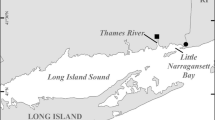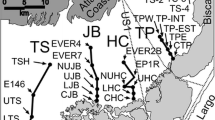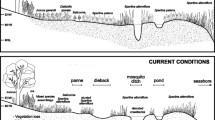Abstract
Ecotones, the narrow transition zones between extensive ecological systems, may serve as sensitive indicators of climate change because they harbor species that are often near the limit of their physical and competitive tolerances. We investigated the ecotone between salt marsh and adjacent upland at Elkhorn Slough, an estuary in California, USA. Over a period of 10 years, we monitored movement of the ecotone–upland boundary, plant community structure, and physical factors likely to drive ecotone response. At three undiked sites, the ecotone boundary migrated about 1 m landward, representing a substantial shift for a transition zone that is only a few meters wide. Analysis of potential correlates of this upward migration suggests that it was driven by increased tidal inundation. Mean sea level did not increase during our study, but inundation at high elevations did. While the ecotone boundary responded dynamically to interannual changes in inundation at these undiked sites, the plant community structure of the ecotone remained stable. At two diked sites, we observed contrasting patterns. At one site, the ecotone boundary migrated seaward, while at the other, it showed no consistent trend. Diking appears to eliminate natural sensitivity of the ecotone boundary to interannual variation in oceanic and atmospheric drivers, with local factors (management of water control structures) outweighing regional ones. Our study shows that the marsh–upland ecotone migrated rapidly in response to environmental change while maintaining stable plant community structure. Such resilience, stability, and rapid response time suggest that the marsh–upland ecotone can serve as a sensitive indicator of climate change.






Similar content being viewed by others
References
Bromirski, P.D., A.J. Miller, R.E. Flick, and G. Auad. 2011. Dynamical suppression of sea level rise along the Pacific coast of North America: indications for imminent acceleration. J Geophys Res 116: 1–13.
Burdick, D.M., and C.T. Roman. 2012. Salt marsh responses to tidal restriction and restoration: a summary of experiences. In Tidal marsh restoration, ed. C.T. Roman and D.M. Burdick, 373–382. Washington, DC: Island Press.
Caffrey, J., M. Brown, W.B. Tyler, and M. Silberstein. 2002. Changes in a California estuary: a profile of Elkhorn Slough. Moss Landing, CA: Elkhorn Slough Foundation.
Callaway, R.M., S. Jones, W.R. Ferren, and A. Parikh. 1990. Ecology of a Mediterranean-climate estuarine wetland at Carpinteria, California—plant distributions and soil-salinity in the upper marsh. Can J Bot 68(5): 1139–1146.
Clarke, K.R. and Gorley R.N. 2006. PRIMER (Plymouth Routines In Multivariate Ecological Research) v. 6. Plymouth: PRIMER-E Ltd.
Committee on Sea Level Rise in California, Oregon, and Washington, Board on Earth Sciences and Resources, Ocean Studies Board, Division on Earth and Life Studies, National Research Council. 2012. Sea-level rise for the coasts of California, Oregon, and Washington: past, present, and future. Washington, DC: The National Academies Press.
Crumley, C.L. 1993. Analyzing historic ecotonal shifts. Ecol Appl 3(3): 377–384.
Cui, B.S., Q.A. He, and Y.A. An. 2011. Community structure and abiotic determinants of salt marsh plant zonation vary across topographic gradients. Estuaries and Coasts 34(3): 459–469.
Elliott, M., and A.K. Whitfield. 2011. Challenging paradigms in estuarine ecology and management. Estuarine Coastal Shelf Sci 94: 306–314.
Flick, R.E., J.F. Murray, and L.C. Ewing. 2003. Trends in United States tidal datum statistics and tide range. J Waterw Port Coast Ocean Eng 129(4): 155–164.
James, M.L., and J. Zedler. 2000. Dynamics of wetland and upland subshrubs at the salt marsh–coastal sage scrub ecotone. Am Midl Nat 143(2): 298–311.
Kirwan, M.L., G.R. Guntenspergen, A. D'Alpaos, J.T. Morris, S.M. Mudd, and S. Temmerman. 2010. Limits on the adaptability of coastal marshes to rising sea level. Geophys Res Lett 37: 1–5.
Kupfer, J.A., and D.M. Cairns. 1996. The suitability of montane ecotones as indicators of global climatic change. Prog Phys Geogr 20(3): 253–272.
Morris, J.T., P.V. Sundareshwar, C.T. Nietch, B. Kjerfve, and D.R. Cahoon. 2002. Responses of coastal wetlands to rising sea level. Ecology 83(10): 2869–2877.
Noble, I.R. 1993. A model of the responses of ecotones to climate change. Ecol Appl 3(3): 396–403.
Page, H.M. 1995. Variation in the natural abundance of N-15 in the halophyte, Salicornia virginica, associated with groundwater subsidies of nitrogen in a southern California salt-marsh. Oecologia 104(2): 181–188.
Peters, D.P.C., J.R. Gosz, W.T. Pockman, E.E. Small, R.R. Parmenter, S.L. Collins, and E. Muldavin. 2006. Integrating patch and boundary dynamics to understand and predict biotic transitions at multiple scales. Landsc Ecol 21(1): 19–33.
Risser, P.G. 1990. The ecological importance of land–water ecotones. In The ecology and management of aquatic–terrestrial ecotones, ed. R.J. Haiman and H. Decamps, 7–21. Paris: UNESCO.
Risser, P.G. 1995. The status of the science examining ecotones—a dynamic aspect of landscape is the area of steep gradients between more homogeneous vegetation associations. BioScience 45(5): 318–325.
Smith, S.M. 2009. Multi-decadal changes in salt marshes of Cape Cod, MA: photographic analyses of vegetation loss, species shifts, and geomorphic change. Northeast Nat 16(2): 183–208.
Stohlgren, T.J., A.J. Owen, and M. Lee. 2000. Monitoring shifts in plant diversity in response to climate change: a method for landscapes. Biodivers Conserv 9(1): 65–86.
Streever, W.J., and A.J. Genders. 1997. Effect of improved tidal flushing and competitive interactions at the boundary between salt marsh and pasture. Estuaries 20(4): 807–818.
Traut, B.H. 2005. The role of coastal ecotones: a case study of the salt marsh/upland transition zone in California. J Ecol 93(2): 279–290.
Van Dyke, E., and K. Wasson. 2005. Historical ecology of a central California estuary: 150 years of habitat change. Estuaries 28(2): 173–189.
Wasson, K., and A. Woolfolk. 2011. Salt marsh–upland ecotones in central California: vulnerability to invasions and anthropogenic stressors. Wetlands 31(2): 1–14.
Wiens, J.A., C.S. Crawford, and J.R. Gosz. 1985. Boundary dynamics—a conceptual framework for studying landscape ecosystems. Oikos 45(3): 421–427.
Williams, P.B., and M.K. Orr. 2002. Physical evolution of restored breached levee salt marshes in the San Francisco Bay Estuary. Restor Ecol 10(3): 527–542.
Yarrow, M.M., and V.H. Marin. 2007. Toward conceptual cohesiveness: a historical analysis of the theory and utility of ecological boundaries and transition zones. Ecosystems 10: 462–476.
Zedler, J.B., J.C. Callaway, and G. Sullivan. 2001. Declining biodiversity: why species matter and how their functions might be restored in Californian tidal marshes. BioScience 51(12): 1005–1017.
Acknowledgments
We are grateful to the many people who helped with monitoring fieldwork over these 10 years: M. Bakker, C. Chabre, N. D'Amore, S. Fork, K. Madden, R. Martone, A. Morrow, J. Nicholson, and R. Preisler. J. Haskins and G. Lessa collected and helped to analyze the water level data that were instrumental to our inundation analyses. J. Haskins provided the precipitation data. K. Hayes provided access to a site managed by the Elkhorn Slough Foundation and R. de Bree and R. Stephens allowed us to approach two sites via Elkhorn Ranch. Two anonymous reviewers provided remarkably extensive and constructive feedback that improved the paper. This research was supported by a grant from NOAA's Estuarine Reserve Division to the California Coastal Conservancy and the Elkhorn Slough Foundation on behalf of the Elkhorn Slough National Estuarine Research Reserve, a partnership between NOAA and the California Department of Fish and Game.
Author information
Authors and Affiliations
Corresponding author
Rights and permissions
About this article
Cite this article
Wasson, K., Woolfolk, A. & Fresquez, C. Ecotones as Indicators of Changing Environmental Conditions: Rapid Migration of Salt Marsh–Upland Boundaries. Estuaries and Coasts 36, 654–664 (2013). https://doi.org/10.1007/s12237-013-9601-8
Received:
Revised:
Accepted:
Published:
Issue Date:
DOI: https://doi.org/10.1007/s12237-013-9601-8




